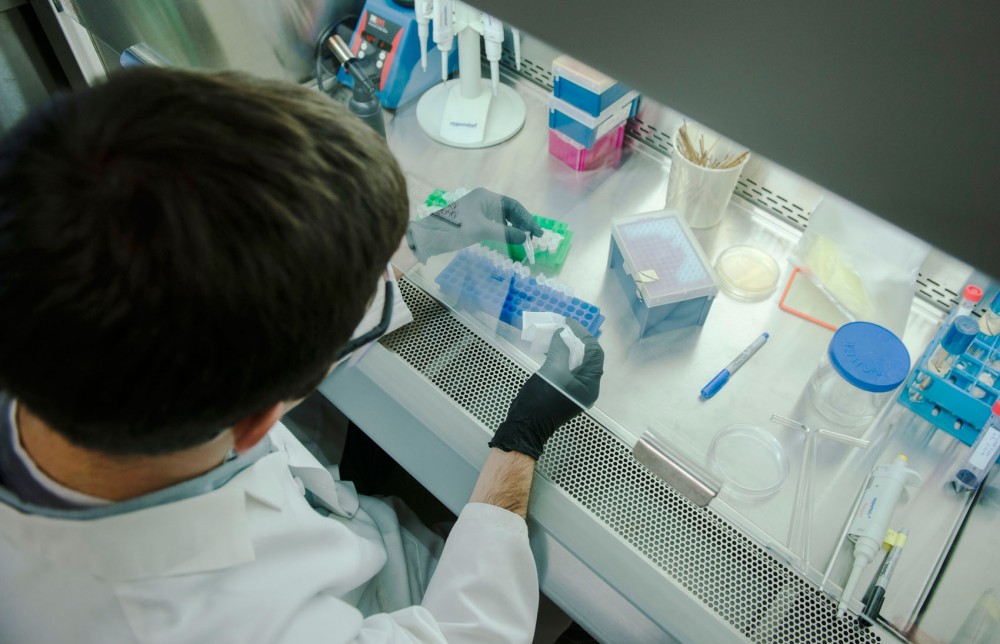University of Minnesota researcher Perry Hackett, calls his breakthrough in using DNA to fight cancer “one of the grandest Minnesota fishing stories ever.”
Hackett, a professor of cell biology and genetics at the University, was given the Impact Award last month for inventing the Sleeping Beauty Transposon system — a basis for many cancer-fighting immunotherapies.
Though Hackett’s scientific journey began nearly 40 years ago when he was tasked with genetically engineering larger fish, his more recent work can reprogram a person’s immune system to fight cancer by introducing a gene into a cell that will recognize foreign cells in the body.
“Your immune system has memory, and it can target specific things that are bad,” he said. “It does so by targeting virus-infected cells and things like that.”
Transposons are DNA that are not uniform throughout an organism — a concept easily seen in Indian corn, where the kernels are multicolored because a DNA element is hopping around the corn genome.
“It’s named Sleeping Beauty because it was a gene that was active … 13 million years ago but went extinct,” Hackett said.
Because this system does not use viruses like other cancer treatments, Hackett said he and his team of three other University faculty members were awarded a grant to research using the system for human gene therapy.
“The problem with viruses is they’re expensive to make, they take a long time to get and they’re very costly to purify,” he said.
But the Sleeping Beauty Transposon is simple enough for an undergraduate student to make. “That’s how trivial this technology is,” he said.
The transposon’s history starts when Hackett accepted a job at the University in 1980 to study retroviruses. He said there were few restrictions on researchers and what they could do in the lab.
He and his colleagues were making mutations in cancer viruses and were not paid much attention.
“A couple of my friends came to me and said, ‘You know how to genetically engineer stuff. We want to make big fish,’” he said, adding that the governor at the time, Rudy Perpich, had asked someone from the medical school how it could help the fishing industry.
Hackett received money from the state and other organizations and successfully created faster-growing fish, but he said many environmentalists at the time were concerned about modified fish being in nature.
Though fish in Minnesota years ago were naturally larger and the fish population worldwide is decreasing rapidly, Hackett said the engineered fish never made it out into the wild.
“All the lakes here in Minnesota are feeling pressure,” he said. “I would say that there now is a global fisheries crisis due to people called environmentalists and people called conservationists. The result is that the natural animal population can’t keep up.”
While Hackett and his team’s engineered fish project came to a halt, he said they made the procedure used on the fish more efficient and eventually came up with a new transposon system.
In the early 2000s, the team merged with the Genetic Cell Biology and Development Department, which was new at the time, and started investing in transposons and gene therapy.
He said viruses have been used in the past to improve the immune system, but a few years ago immunotherapy became the focus.
“Fundamentally, it’s a fishing story,” Hackett said of creating the transposon system. “It is one of the grandest Minnesota fishing stories ever. You start to find a way to improve the lives of fishermen and you wind up with a cutting-edge tool to treat cancer.”
Dan Voytas, a genetics, cell biology and development professor and the director of the Center for Genome Engineering, said he took a job at the University in 2008 partly because of Hackett’s work in genetics.
Voytas said he first met Hackett shortly after the transposon discovery was made.
“Part of the motivation for the move was certainly my excitement about working with professors at the University of Minnesota who are interested in editing [and] modifying DNA in cells,” he said.
Voytas sees the Sleeping Beauty Transposon System as Hackett’s greatest contribution to the University.
“It has many applications,” he said. “It’s been helpful in understanding how cancer progresses. It’s been important … to correct genetic diseases that people inherit. More recently it’s been important in turning our immune systems against cancer.”
Voytas said the recent immune system discovery was commercially licensed in the last year and a half. Since Hackett’s discovery, he said there have been other developments that allow DNA to be more precisely edited.
The Center for Genome Engineering implements other people’s systems into editing human, animal and plant genes, Voytas said.
He added that in the future, therapies based on Hackett’s transposon system could eliminate or correct the symptoms of inherited diseases.
“It’s the therapeutic outcomes of that technology that people will appreciate and recognize,” he said.
Allen Levine, the University’s interim vice president for research and a member of the committee that awarded Hackett, said he was given the award in March because of his discovery and use of the Sleeping Beauty Transposon system.
“I’ve heard a lot about [Hackett] over the years,” Levine said. “The work that he has done has had a major impact in terms of cancer therapies.”
Levine said most cancer therapies, which are relatively new, look to change the immune system to attack only cancer cells. He said 80 percent of people who use this technology have complete recovery or remission of cancer.
“The University will keep on working in these arenas,” he said. “We want to reward that innovative thinking. I always say that genius is the recognition of the accident.”

















